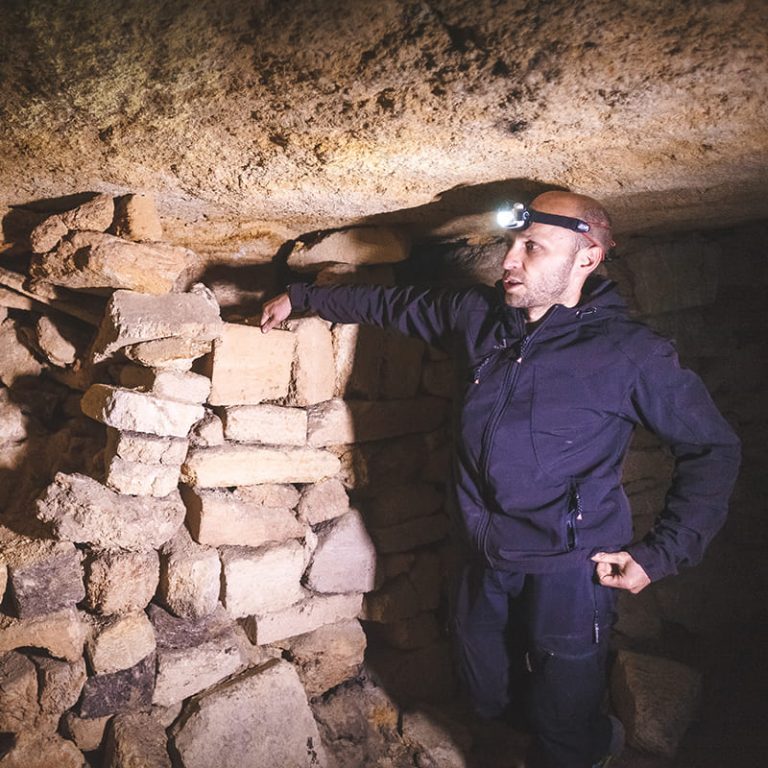Guerrilla camps in limestone mines, wineries, underground museums, karst caves, and lakes… All of this lies underneath the city of Odesa and its outskirts, where one of the world’s largest catacomb networks stretches for several thousands of kilometres. The catacombs continue to grow, as after the annexation of limestone-rich Crimea, rock extraction has intensified on the Black Sea coast.
Over three centuries ago, cities and villages near the Black Sea were built using rock mined from underground: namely coquina, which formed at the bottom of the Pontic Sea (now the Black Sea) around six million years ago. The urgent need for building materials arose during the development of Odesa and its outskirts in the late 18th to early 19th centuries.
Coquina
A type of limestone that consists mainly of the shells (both whole and fragmented) of molluscs and other marine invertebrates.At first the rock was mined by hand, but mechanical extraction methods (involving specially-adapted saws) came into use in the early 19th century,.
The consequences of this kind of mining can still be found in the Odesa catacombs and underneath the nearby villages of Usatovo, Kryva Balka, Nerubaiske, Kuialnyk, Zhevakhova Hora, and Kholodna Balka.

These age-old mines — cavities created artificially, as a result of rock extraction — are called catacombs (from the Greek word katakymbos, meaning ’deepening’) by locals and spelestologists. The first so-called catacombs were the underground passages of the early Christian period — namely, the passages under the Basilica of St Sebastian in Rome, which served as burial chambers.
Spelestologist
The Ukrainian language has a specific term to denote a researcher who studies artificial underground cavities (as opposed to naturally-occuring caves, which are studied by speleologists). Spelestologists study abandoned mines, sewers, as well as underground cities, places of worship, and industrial facilities.The Odesa catacombs are known as one of the longest underground labyrinths in the world, with a total length of 2,500 kilometres. Other famous labyrinths within the territory of Ukraine include the Adzhymushkaiski quarries near the city of Kerch, where thousands of partisans and local residents hid during World War II.
The Black Sea catacombs do not form a continuous system, since each mine was created separately and parallel paths formed in different areas. They are also separated by numerous valleys and lowlands, features of the local landscape.
The Odesa catacombs stretch along the coastline for 80 to 100 kilometres, with mines at depths ranging from six to 38 metres below the surface, forming unsystematic labyrinths that periodically collapse, prompting a ban on new construction in Odesa.

Labyrinths of Catacombs
The villages of Nerubaiske and Usatove were founded by the Zaporizhian Cossacks after the Empress of Russia, Catherine II, liquidated the Zaporizhian Sich in 1775. The Cossacks came here, across the steppes of the Black Sea, in order to fish and to mine salt and coquina.
In order to extract these resources and use them to build homes, the Cossacks began to walk on the former ‘seabed’. On the slopes of the steep banks they would build the outer wall with windows, and the rest of the home would be hewn out of the stone.
Beneath Nerubaiske there is a large stretch of catacombs — the exact number remains unknown — that connects with the Odesa city catacombs. There are around a thousand catacombs outside the city, including basements, mines, wells, and points of access on privately-owned land.
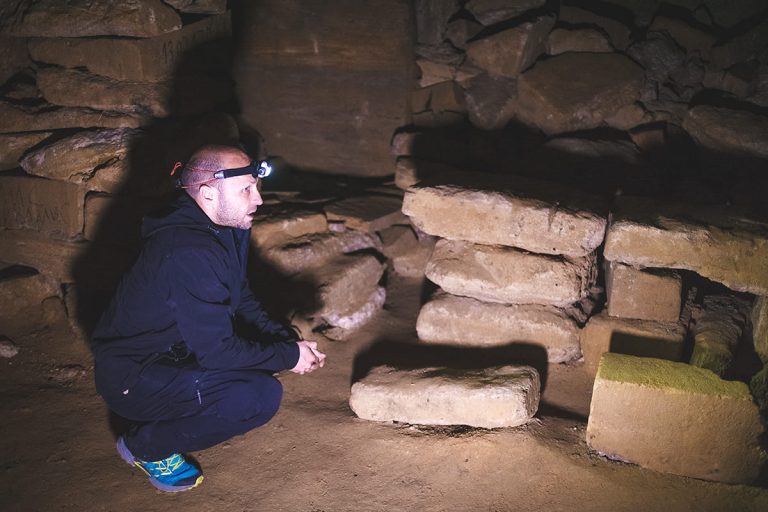
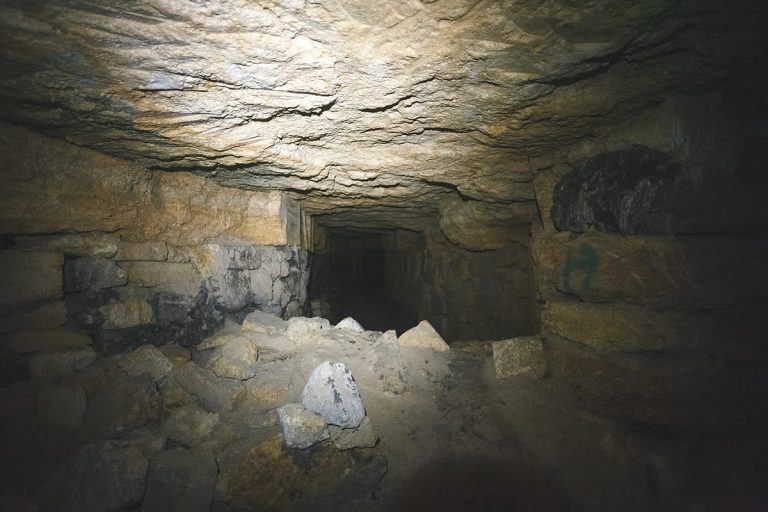
slideshow
According to spelestologist and researcher Dmytro Vovchenko, the largest pit fields are located outside Odesa, near the village of Kryva Balka. There, you can walk for over 50 kilometres on two levels, without coming up to the surface.
Dmytro describes his first descent underground:
“I first went underground with friends at the age of eight — it was the system of catacombs in Usatove. I was fascinated by labyrinths and secrets. It all reminded me of adventure films about the Count of Monte Cristo. For a boy, it was just the normal spirit of an explorer, prepared to go into a dark zone, where the unknown lies in wait around every corner.”
Now Vovchenko already has 20 years of experience studying the Odesa catacombs. In 2008, a team of Odesa activists created the community organisation ‘Pamiat’ (‘Memory’ — tr.), of which Dmytro is a member. It aims to unite speleologists and spelestologists, scientists, researchers, and regular explorers of the local catacombs.
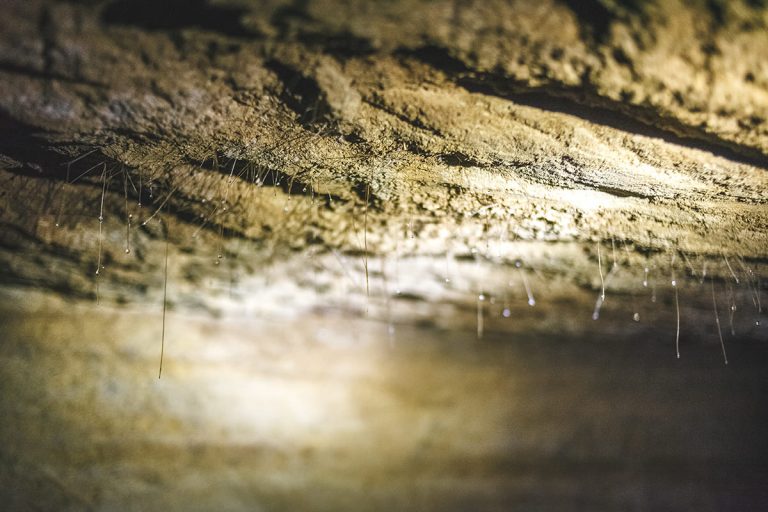
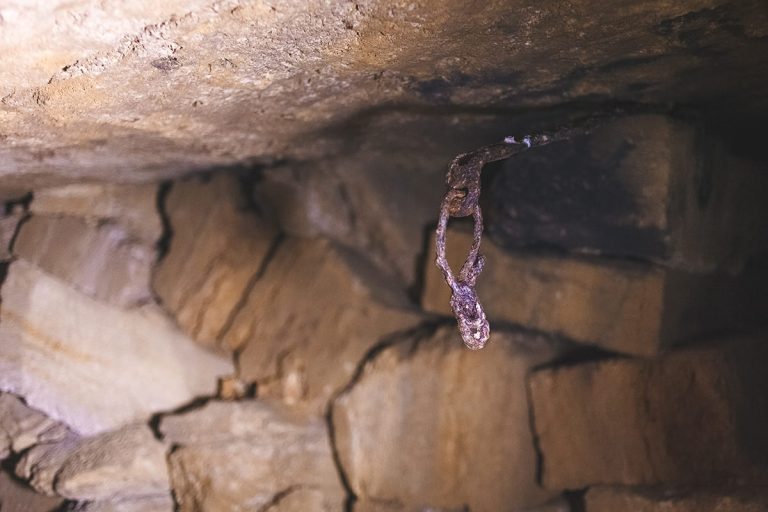
slideshow
Spelestologist Oleh Mazurenko first went underground at the age of 17. Now, at the age of 38, he shares his observations and experiences with others:
“I’m always interested in any place you can climb into and explore. I don’t make money from it, I just love showing people these places for fun. Then I see the catacombs through their eyes.”
Almost every village near Odesa has a system of mines. The result is an extensive network of underground passages between villages: for example, you can walk underground from Nerubaiske to Kholodna Balka. Moreover, there are around five large World War II bomb shelters with well-established ventilation and fresh water supplies.
The passageways and mines of the local catacombs were used at different times as hiding places. It is rumoured that Odesa’s criminal kingpins used to hide here to conduct underground smuggling operations.

According to Oleh, the quarry later served as a kind of porto franco:
Porto franco
A port that has the right to duty-free import and export of goods and does not belong to the state customs territory.“This was a free trade zone. For example, it wasn’t Turkish tea that came out from under the ground, but already ‘Odesa tea’. These products were repackaged and sold in the USSR or exported abroad.”
During the Nazi occupation, bunkers and passages were built here that could be used to escape the city.
The main tourist attraction in the local labyrinths is the Museum of Partisan Glory, created in 1969 in the Nerubaiske catacombs. During World War II, a large detachment of partisans used these catacombs as a hiding place. According to Oleh Mazurenko, there are several landmarks in the Odesa quarries dedicated to the memory of local partisans:
“There was a partisan camp in this place; traces of camp life were found here. There are people who come to search for relics from that time. If you find a German dagger here, for example, it’ll motivate you to keep on searching. Such exclusive finds were common in the past. Now they are a rarity. Most often, people find ammunition and cartridges.”

Spelestologists, like other professional communities, have their own special practices. Not far from the partisan camp is a place that researchers call the ‘baptism hall’, which was dated in 1972. Nearby there is a stone ‘table’ for 150-200 people; behind it is a lake for swimming:
“This is a 70 or 80-year-old ritual. In the past, you could not join the caving club without it. And you couldn’t get underground unless you were with the club. I show this lake to everyone I bring here.”
Today on the walls of the catacombs a great many inscriptions can be seen: poems, drawings, stories, boundary lines, and warnings stating “do not mine”.
The entrances to the quarries, which were located directly below people’s homes, were previously used by local residents as pantries for food storage. According to Oleh, a local winery has long sworn by these underground wines and cognacs:
“They built a glass pipe, which they used for filling the barrels. Now there are only arched halls with stone ceilings that were built to reinforce the structure and prevent landslides. If you crawl along for several hours, you can find yourself in someone else’s wine cellars.”
According to Oleh, there was a well-established drainage system in these cellars back then: water and moisture were not retained here. There were several halls, each one 25 to 30 metres long, where barrels of wine were stored. Due to landslides in recent years, these premises have unfortunately been flooded.

Culture and Life Underground
The coquina lies 30 to 50 metres below Odesa, where mining is difficult. Plus, most of these areas are flooded: 5 to 7% have remained above water. As a result, any new construction in areas above the catacombs is becoming increasingly complex and requires prior assessment by specialists:
“If they are building a new neighbourhood in a place that could have mines underneath, then specialists come and drill boreholes, go down there, and look for cavities.”
If the mines become fragile and unstable, the catacombs are filled with water and sand to prevent landslides. This was done with most catacombs in the Soviet period.
Substandard stones are placed under the walls, thus strengthening them. This process is called ‘zabutovka’ (a word derived from the Ukrainian word for ‘rubble’ — tr.).
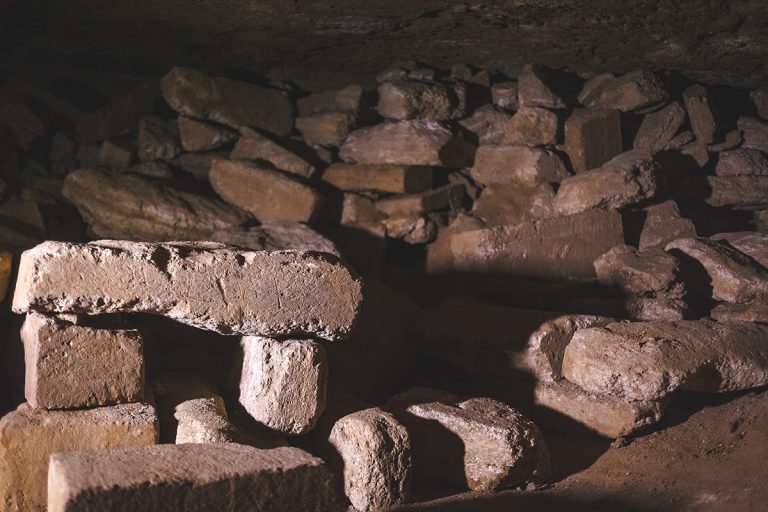
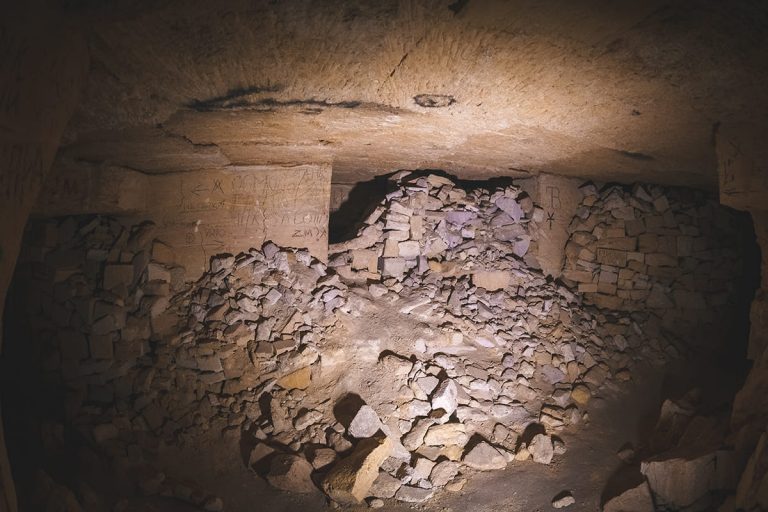
slideshow
The catacombs have their own microclimate: 100% humidity and a constant temperature of 12-14 degrees Celsius. All organic matter here decays very quickly. Oleh Mazurenko affirms that if you leave an old newspaper down here, it will be totally gone within a year. Oleh, goes underground dozens of times a year with other spelestologists. To avoid bringing their own things underground, researchers usually set up camps there:
“The base we stay at during expeditions changes periodically. There is always food: cans, dried goods, water, sleeping bags, and basic necessities, set up in the form of an underground base camp.”
At bases like these, flat stones are laid out tightly to form a table. Rubble is used to level the floor and walls. The base must be established in a dead end, in a dry part of the cave. During expeditions, this becomes the spelestologists’ ‘home’ for several days and nights.
“Phones don’t work here, radios don’t work, nothing works. Here there’s only you, and that’s it. The silence here, there’s nothing like it anywhere else. There are just drops of water and the occasional draught. If you turn off the light, then there is a darkness like nothing else. Some people can’t sleep at night here. Their circadian rhythms get thrown off course and they don’t know whether it’s night or day.”
Every spelestological researcher needs a toolkit containing a torch, a map, and several sets of batteries, which can often deteriorate due to the moisture. Having a torch and a map is the primary safety measure underground, according to Oleh.

When the Black Sea catacombs were being actively studied, there was an urgent need to create detailed maps, for the purpose of searching for missing persons and to create a standard register. Since 1965, the Odesa caving club, ‘Poshuk’ (‘Search’ — tr.) has been working on the topography:
“When the cartographic movement got underway here, every self-respecting underground enthusiast had to have their own mark which they would put on the walls.”
But among all the marks used by the explorers, there is one in general use: a crossed-out square, meaning ‘no-go zone’. If someone ignores the sign or is trapped by a rockfall, a rescue mission is carried out by workers from the State Emergency Service and members of ‘Poshuk’, who know the exact location of the mines.
“In 1973, two boys got lost in the Odesa catacombs. During the course of the search, the boys were found, as well as a passage to a cave that connected two systems of catacombs.”

In the catacombs, in addition to the man-made cavities, you can access natural karst caves.
Among the caves that have been found, 11 have been investigated. However, there are almost 70 in total; that is, 7,150 metres of darkness. The most famous are Natalina cave (1,290m), Novorosiiska (1,450m), and Hniva cave (400m). These are either horizontal, straight galleries or intersecting ones. Now they can only be accessed via a quarry:
“They have no entrances, and some of them are completely flooded. A lot of water has collected there. Sometimes there are places where you can even go by boat and dive in a wetsuit to find new places.”

Activists
As well as providing information about historical events that unfolded here, the Odesa catacombs can tell us much about the development of urban infrastructure on the Black Sea coast. Historians and ‘diggers’ (underground urban explorers — ed.) are most interested in civil defence and security systems, storm drains, and sewerage systems. Most of these are not in operation nowadays.
The catacombs are also of interest to members of the Ukrainian Speleological Association, caving clubs ‘Poshuk’ and ‘Meridian’, a group of geology researchers from the Illia Miechnikov Odesa University, and special units of the Ukrainian national police who train in the catacombs.

Unfortunately, some locals use the catacombs for other purposes:
“Some people use these caves in another cunning way: they drill holes in the ground and use them as a virtually endless dump. Nothing needs to be taken away, as the smell doesn’t reach the surface. The saddest part is that there is no punishment for this. Well, apart from closing up the hole and putting a smoke bomb or yeast in there.”
Spelestologists often come across offenders like these, so there are now regular actions aimed at protecting the catacombs. Activist Oleksandr Romanov organises excursions and ecological work parties in the catacombs. His eco-conscious team use iron brushes to clean intruders’ graffiti from the walls of the catacombs; they also collect rubbish that locals throw in through holes above.
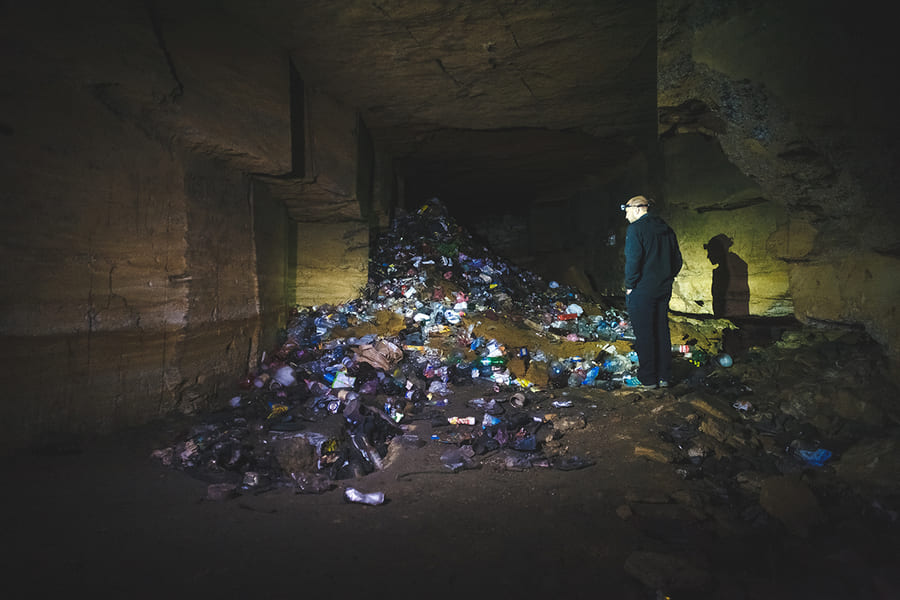
While the locals use them as a landfill site, interest in the catacombs is growing, both in Ukraine and abroad:
“These mines are a necessity for anyone focused on domestic tourism, as well as those who wish to attract tourists and researchers from abroad. This includes people from the Baltic states, Belarus, Poland and Israel.”
In the past three years, cooperation with similar foreign organisations has intensified, according to Dmytro Vovchenko.
Not all first-time visitors are able to find their way around easily:
“Every year, there are people who go underground and get lost. The search and rescue team tracked down its most recent finds by the smell that had been in the catacombs for quite some time. So it’s best to say where you’re going, at what time you set out, and when you plan to return, so that they can send out a search party. It really takes two days to go through the whole system.”
Vovchenko says that it is often introverts — hardworking and focused — who are interested in exploring the catacombs. After all, you need a certain mindset to enjoy a hobby like this and work on it proactively. It helps to be cautious and observant, and to feel comfortable in complete darkness, silence and solitude.
“I’ve seen four-year-old children being brought into the catacombs and told tales of gnomes and hidden treasures. Meanwhile, teenagers come to the catacombs for a dieselpunk, post-apocalyptic, ‘stalker’-like atmosphere.”
The same young people — who, over time, become seriously interested in local lore, history and archaeology — often remain part of the movement.
Stalker
In Ukrainian, the word ‘stalker’ is used to describe those who explore forbidden places. The term originates from ‘Roadside Picnic’, a 1972 Russian science-fiction novella, and was opularised by the ‘S.T.A.L.K.E.R.’ videogame series, set in the Chornobyl exclusion zone.
The Odesa catacombs continue to grow to this day. Since the temporary occupation of Crimea by Russia, the extraction of Black Sea coquina has once again become a topical issue. Today, the practice is often crude and uncontrolled, and it is done underground, where there is a wealth of valuable information about the history of the region, its culture, and the life of its locals over the past few centuries.
“Above our heads, people are frying fish, children are going to school, sick people are being treated; above our heads, people are living and dying. And we continue. We go on.”

